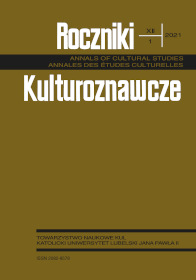Dancing as Environmental Aesthetics from Indigenous America
Abstract
Contemporary studies on environmental aesthetics emphasize the relationship of continuity between nature and human action. Most of these critical approaches suggest that the emphasis on the continuity of nature with humanity implies a change of attitude to the natural environment, meaning that we should move away from the exploitation of the natural environment and focus on its preservation and conservation. In the two sections of this paper, it is argued that the idea for the continuity of humans with the natural environment has for a long time been a core philosophical belief in indigenous America, the oldest aesthetic manifestation of which has been expressed in the forms of dancing. The first section is dedicated to the idea of continuity in indigenous America, emphasizing on the concepts of Mother Nature and Human Spirit. The second part shows that native dancing embodies aesthetically the idea of continuity of human action and the natural environment.
References
Alexander, Hartley Burr. 1953. The World’s Rim: Great Mysteries of the North American Indians. Lincoln, NE: University of Nebraska Press.
Cassirer, Ernst. 1995. The Philosophy of Symbolic Forms, Volume II: Mythical Thinking. New Haven and London: Yale University Press.
Chadwick, Allen. 1998. “Blood as Narrative/Narrative as Blood: Declaring a Fourth World.” Narrative 6, no. 3: 236-255. https://www.jstor.org/stable/20107155.
Chindoy, Juan A. 2020. A Decolonial Philosophy of Indigenous Colombia: Time, Beauty, and Spirit in Kamëntšá Culture. London: Rowman & Littlefield Publishers.
Collingwood, Robin George. 2019. Idea de la Naturaleza. Translated by Eugenio Imaz. México: Fondo de Cultura Económica.
Dewey, John. 1934. Art as Experience. New York: Penguin Group.
Eaton, Marcia Muelder. 1999. “Kantian and Contextual Beauty.” The Journal of Aesthetics and Art Criticism 11–15. https://www.jstor.org/stable/432059.
Eliade, Mircea. 1963. Myth and Reality. Long Grove, IL: Waveland.
Engle, Karen. 2018. El Desarrollo Indígena, Una Promesa Esquiva. Bogotá: Siglo del Hombre Editores.
Galeano, Eduardo. 2018. Las Venas Abiertas de América Latina. México: Siglo XXI Editores.
Garcilaso de la Vega, Inca. 1609. Comentarios Reales de los Incas: Primera Parte. Lisboa.
Hall, Joshua M. 2017. “St. Vitus’s Women of Color: Dancing with Hegel, Comparative and Continental Philosophy.” Comparative and Continental Philosophy 9 , no. 1: 43–61.
Hanna, J. Lynne [et al.]. 1979. “Movements Toward Understanding Humans Through the Anthropological Study of Dance [and Comments, and Reply].” Current Anthropology 20, no. 2: 313–33. www.jstor.org/stable/2741929.
Hegel, Georg Wilhelm Friedrich. 2006. The Philosophy of Art. New York: Barnes & Noble.
Hultkrantz, Åke. 1979. The Religions of the American Indians. Translated by Monica Setterwall. Berkeley: University of California Press.
Jahner, Elaine. 1992. “The Spiritual Landscape.” In D.M. Dooling and Paul Jordan-Smith. I Become Part of It: Sacred Dimensions in Native American Life. New York: Haper Collins.
Kennedy, Christina B., James L. Sell, and Ervin H. Zube. 1988. “Landscape Aesthetics and Geography.” Environmental Review 12, no. 3: 35–51. https://www.jstor.org/stable/ 3984284.
Lamprea Montealegre, Everaldo. 2019. El Derecho de la Naturaleza: Una Aproximación Interdisciplinaria a los Estudios Ambientales. Bogotá: Siglo del Hombre Editores.
Momaday, N. Scott. 1997. The Man Made of Words. New York: St. Martin’s Griffin Press.
Muehlebach, Andrea. 2001. “‘Making Place’ at the United Nations: Indigenous Cultural Politics at the U.N. Working Group on Indigenous Populations.” Cultural Antropology 16, no. 3: 415–448.
Praet, Istvan. “Shamanism and Ritual in South America: An Inquiry into Amerindian Shape-Shiting.” The Journal of the Royal Anthropological Institute 15 (2009), no. 4: 737–754. www.jstor.org/stable/40541752.
Solomon, Thomas. 2000. “Dueling Landscapes: Singing Places and Identities in Highland Bolivia.” Ethnomusicology 44, no. 2: 257–280. www.jstor.org/stable/852532.
Toelken, Barre. 2003. “Cultural Patterns in Native American Folklore: An Introduction.” In Barre Toelken. Anguish Of Snails: Native American Folklore in the West, 9–24. Logan, UT: University Press of Colorado.
Toelken, Barre. 1992. “The Demand of Harmony.” In D.M. Dooling and Paul Jordan-Smith. I Become Part of It: Sacred Dimensions in Native American Life, 59–71. New York: Haper Collins.
Van Gijseghem, Hendrik, and Verity H. Whalen. 2017. “Mining, Ritual, and Social Memory: An Exploration of Toponymy in the Ica Valley, Peru.” In Rituals of the Past: Prehispanic and Colonial Case Studies in Andean Archaeology, edited by Silvana Rosenfeld and Stefanie L. Bautista. Boulder, 267–294. Colorado.: University Press of Colorado.





